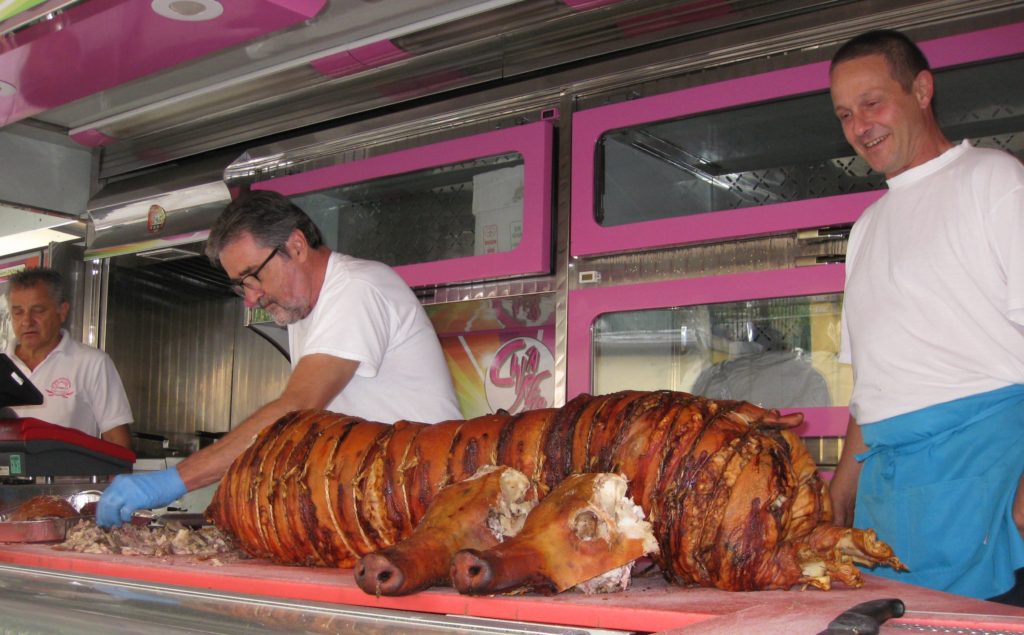Porchetta, a beloved Italian delicacy, is a sumptuous, savory, and aromatic roast pork dish that has been cherished for centuries. Originating from central Italy, particularly in regions like Lazio and Umbria, porchetta is celebrated for its flavorful, tender meat and crispy, golden-brown skin. This culinary masterpiece is more than just a dish; it is a testament to Italy’s rich gastronomic heritage and the art of slow-cooking.
Historical Roots and Cultural Significance
Porchetta’s roots can be traced back to ancient Roman times when the technique of roasting whole pigs was a common practice during feasts and celebrations. Over the centuries, this method evolved, incorporating a variety of herbs and spices that define the dish today. In Italian culture, porchetta is more than just food; it is a symbol of community and festivity. It is often prepared for special occasions, festivals, and family gatherings, where its preparation and sharing bring people together.
The Art of Making Porchetta
The process of making porchetta is an intricate and meticulous one, requiring skill and patience. Traditionally, a whole pig is deboned and seasoned with a mixture of garlic, rosemary, fennel, and other herbs, then rolled and roasted over a wood fire. The result is a dish that is juicy and flavorful on the inside, with a perfectly crispy exterior.
While the traditional method involves using a whole pig, modern variations often use pork loin or belly for convenience. The key to a successful porchetta lies in the seasoning and the roasting technique. The herbs and spices must be generously applied, and the meat should be cooked slowly to ensure it remains tender and moist while achieving a crispy skin.
Regional Variations
Different regions in Italy have their unique take on porchetta, each adding its twist to the classic recipe. In Lazio, particularly in the town of Ariccia, porchetta is renowned for its rich flavor and is often enjoyed in sandwiches, known locally as “panino con porchetta.” This version typically features a stronger presence of rosemary and garlic.
In Umbria, the seasoning blend includes wild fennel, which imparts a distinctive aroma and taste to the dish. The Umbrian porchetta is also known for its meticulous preparation process, where the meat is often marinated overnight before roasting.
Porchetta in Modern Cuisine
Porchetta has transcended its traditional roots and found a place in contemporary cuisine worldwide. Chefs and home cooks alike have embraced this versatile dish, incorporating it into various culinary creations. From gourmet sandwiches to pasta dishes, porchetta’s rich flavor and succulent texture make it a popular choice.
In the United States, porchetta has become a trendy street food, with food trucks and markets offering their versions of this Italian classic. The porchetta sandwich, with its layers of tender pork, crispy skin, and a medley of fresh and pickled vegetables, has become a favorite among food enthusiasts.
Health Considerations
While porchetta is undoubtedly delicious, it is also a rich and indulgent dish. The high-fat content, particularly from the crispy skin, makes it a treat best enjoyed in moderation. For those mindful of their health, there are ways to enjoy porchetta with a healthier twist. Opting for leaner cuts of pork, reducing the amount of added fat, and pairing it with plenty of vegetables can make the dish more balanced.
Cooking Porchetta at Home
Making porchetta at home can be a rewarding culinary adventure. Here is a simplified recipe to try:
Ingredients:
- 1 pork loin or belly (about 5-6 pounds)
- 6 cloves garlic, minced
- 2 tablespoons fresh rosemary, chopped
- 2 tablespoons fresh sage, chopped
- 1 tablespoon fennel seeds, crushed
- 2 tablespoons olive oil
- Salt and pepper to taste
- Zest of one lemon
Instructions:
- Preheat your oven to 325°F (165°C).
- Lay the pork loin or belly flat and score the skin with a sharp knife.
- In a bowl, mix garlic, rosemary, sage, fennel seeds, olive oil, salt, pepper, and lemon zest.
- Rub the seasoning mixture all over the pork, ensuring it is well-coated.
- Roll the pork and tie it securely with kitchen twine.
- Place the pork on a roasting rack in a baking dish and roast for about 3-4 hours, or until the internal temperature reaches 145°F (63°C).
- Increase the oven temperature to 450°F (230°C) for the last 20 minutes to crisp up the skin.
- Let the porchetta rest for 15 minutes before slicing.
Conclusion
Porchetta is a culinary gem that showcases the richness of Italian cuisine. Its blend of aromatic herbs, succulent meat, and crispy skin makes it a dish that is both comforting and celebratory. Whether enjoyed in a traditional setting or as part of a modern culinary creation, porchetta continues to captivate food lovers around the world. Its enduring appeal lies in its perfect balance of flavors and textures, making it a timeless favorite that transcends generations and borders
